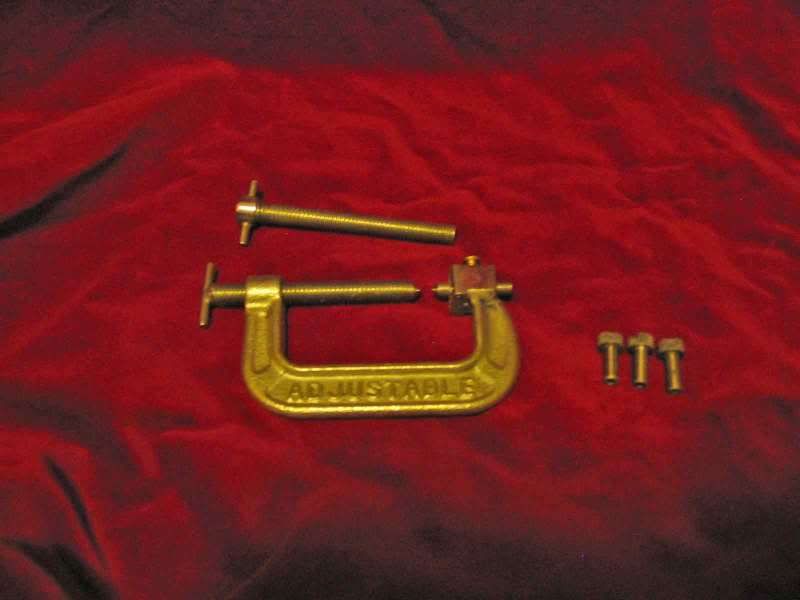Pauls method works fine for a straight barrel if you have the necessary drill press and a piece of material to use as a guide but it can get a person into trouble if the barrel is swamped.
I usually locate the pin hole by measuring from the top flat of the barrel to the bottom of the underlug with my dial calipers.
I repeat this measurement at each underlug and then measure the actual barrel flats to make sure I know what its thickness is at each location.
I then draw a little picture of the barrel and underlug and mark the dimensions.
On a swamped barrel I also measure the size of the octagon at the underlugs location and the dimension from the top flat of the barrel at that location to the bottom of the underlug.
I will repeat this measurement several times to make absolutely sure I have not transposed a number.
When I am sure I have the right dimensions I put them onto the barrel sketch for future reference.
In the case of a swamped barrel this measurement is necessary at each underlug and each barrel/underlug sketch is clearly identified.
Knowing the dimension to the bottom of the underlug I then subtract it from the barrel thickness at that location. I divide this answer in half and then add it to the barrel thickness.
This gives me the location for the pin as measured from the top flat.
I then set the dial caliper to read this dimension and lock it in place with the locking screw.
Replacing the barrel into the stock and lightly clamping it using small C clamps I then place a straight piece of steel across the top of the barrel at the underlug location. I don't clamp it there but it may help to keep it from moving if you do.
Using the "inside" measuring features of the Dial Caliper I place one of them on the underside of the piece of steel and using the other point I scribe a line on each side of the stocks wood. (It will be sanded off later).
Using a small combination square to determine squareness with the stocks sides I then draw a line down each side with a pencil. Where this line crosses the horizontal scribed lines that were made by the caliper shows where the pin hole should be drilled.
Here is where it gets interesting for those without a drill press or a little "drill jig" like the one I made.
If you don't have either of these you need to get a helper. His/her job will be to stand at your right or left and to tell you when you are holding the electric drill square with the world.
Then, keeping your fingers crossed and paying attention to keeping the drill straight to your line of sight and to the instructions of your helper you drill thru the stock at the mark you've made.
If you are careful everything will go great and the drill will hit the underlug right where it should.
Note: Sense you are drilling "blind" thru the underlug don't force the drill. Keep a medium pressure on it and let it do the work of making the hole. Now is not the time to break off that little drill bit.
Speaking of drill bits, I use a 5/64 diameter bit and a 5/64 diameter drill rod to make the barrel pin. My reason for this is I believe it is just too damn easy to break the smaller 1/16 inch drill bits off and the larger 5/64 diameter drill is longer. This longer length allows the drill to go all the way thru the stock from one side. (You really don't want to try to drill these pin holes from both sides. They almost never meet in the middle).
After drilling one hole thru, put a 5/64 pin thru it to keep the barrel from moving. Then repeat the whole thing at the remaining underlugs.
There are few tasks in building a rifle that can break you out in a cold sweat like drilling the underlug pin holes. :grin:
Oh, if you find that you have missed the underlug with your drill bit all is not lost. You will just end up with a fancier rifle than you though you would build.
Noting the location of the bad hole, mark a place on the side of the stock that would put the pin hole in the right place on the underlug.
Then replace the barrel, clamp it and redrill the hole in the right place. When you've got the hole in the right place and it is passing thru the underlug like it should then get out your catalog and pick out a nice suitable brass or German Silver inlay and order it. It will cover the "bad" hole nicely.

In my opinion, if you do have to install inlays to cover the bad holes you should order enough of them to be used at all of the pin holes even if they are in the right place. That way it will look like it was a planned design and not an after thought.
Have fun. :grin:







